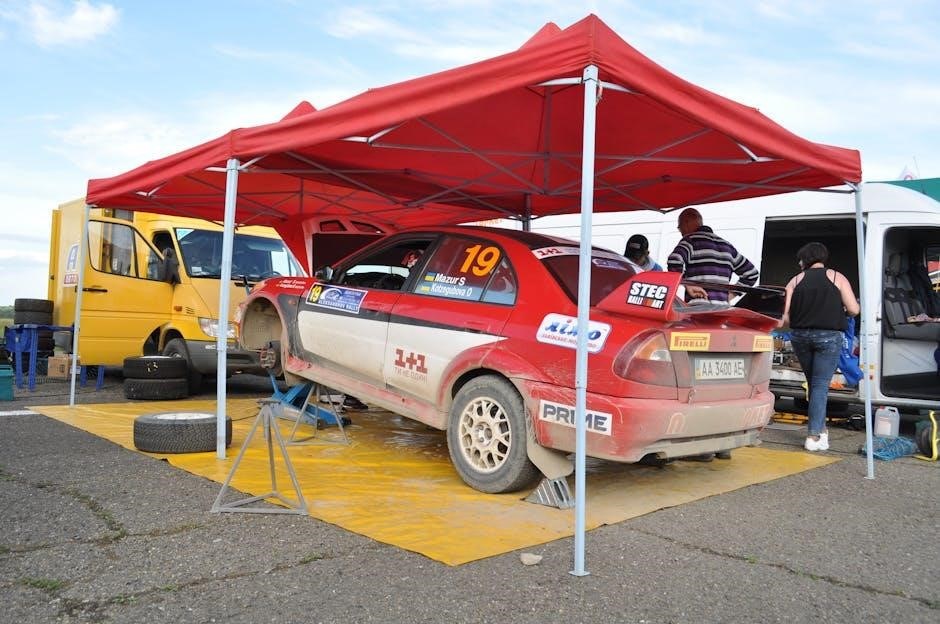
Overview of Canopy Tent Setup
Setting up a canopy tent involves understanding the basic steps. It ensures a successful and safe installation. From unpacking components to securing the structure, each phase is critical. This overview will guide you through the essential stages, providing a foundation for more detailed instructions.
Purpose and Benefits of Canopy Tents
Canopy tents serve multiple purposes, making them ideal for various outdoor activities. Primarily, they offer protection from the elements, shielding users from harsh sunlight, rain, and wind. This makes them perfect for events like farmers markets, craft fairs, and outdoor gatherings. A canopy tent creates a comfortable, shaded area, preventing sunburn and heatstroke.
Beyond protection, canopy tents provide a designated space for businesses to showcase products or services. They enhance visibility and create a professional appearance. For recreational use, they define picnic areas, camping spots, or backyard party zones. Their portability and ease of setup make them convenient for temporary shelters.
Moreover, canopy tents can be customized with branding, logos, and decorations, enhancing event aesthetics and promoting brand awareness. Sturdy construction ensures durability, and various sizes accommodate different group sizes and needs. Overall, canopy tents are versatile, practical, and cost-effective solutions for outdoor shelter and event enhancement.
Types of Canopy Tents (Pop-Up, Frame)
Canopy tents come in various designs, each offering unique features and benefits. Two primary types are pop-up and frame tents. Pop-up canopies, also known as instant canopies, are designed for quick and easy setup. They feature a pre-assembled frame that expands like an accordion, requiring minimal effort. These are ideal for events needing fast setup and takedown, like markets or picnics.
Frame tents, on the other hand, consist of separate poles and connectors that form the tent’s structure. While they require more assembly time, frame tents offer greater stability and customization options. They are suitable for longer events or locations needing a sturdier shelter. Frame tents can also accommodate sidewalls and other accessories for added protection.
Choosing between pop-up and frame tents depends on specific needs. Consider setup time, portability, and required durability. Pop-up tents prioritize convenience, while frame tents offer enhanced stability and customization for more demanding situations.

Pre-Setup Preparation
Before beginning, thorough preparation is key for a smooth canopy tent setup. This includes reviewing instructions and selecting the optimal site. Proper planning minimizes issues and ensures a safe, efficient process for your outdoor event.
Reviewing Manufacturer Instructions
Before you even think about unfolding a leg or snapping a pole into place, the very first step in ensuring a successful and stress-free canopy tent setup is to thoroughly review the manufacturer’s instructions. Yes, it might seem tempting to just dive in and figure it out, but these instructions are specifically tailored to your tent model and can save you a significant amount of time and frustration.
These documents often contain crucial information, such as identifying all the components, understanding the proper sequence of assembly, and highlighting any specific safety precautions. Ignoring these guidelines could lead to incorrect assembly, potential damage to the tent, or even injury.
Pay close attention to diagrams and illustrations, which can often clarify steps more effectively than words alone. Take note of any warnings about wind conditions, weight limits, or specific techniques for extending the frame. The manufacturer knows their product best, so treat their instructions as your roadmap to a perfectly erected canopy. After all, a little reading can prevent a whole lot of struggling later.
Site Selection and Considerations
Choosing the right location for your canopy tent is paramount for its stability, longevity, and your overall comfort. Before you even unpack your tent, take a careful look around the area. Opt for a level surface whenever possible to ensure even weight distribution and prevent the frame from warping or collapsing under stress. Avoid areas with significant slopes or dips, as these can compromise the tent’s structural integrity.
Consider the ground surface itself. Is it soft grass, hard-packed dirt, or concrete? The type of surface will influence the type of anchoring you’ll need – stakes for soft ground, weights for hard surfaces. Also, be mindful of potential hazards like overhead power lines, tree branches, or underground utilities.
Finally, think about the prevailing wind direction. Orienting your tent with its most solid side facing the wind can minimize stress on the structure. Taking these site considerations into account beforehand will contribute significantly to a safe and enjoyable experience under your canopy.
Step-by-Step Setup Instructions
The following instructions provide a clear guide for setting up your canopy tent. Each step will ensure a secure and functional shelter. From frame assembly to fabric attachment and anchoring, follow carefully for optimal results and a pleasant experience.
Unpacking and Component Identification
Begin by carefully unpacking your canopy tent from its storage bag. Lay out all the components on a clean, flat surface. This allows for easy identification and prevents loss of smaller parts. Refer to the manufacturer’s instructions for a detailed parts list. Typically, you’ll find the frame (pre-assembled or in sections), the canopy fabric, stakes, ropes, and possibly sandbags or weights.
Identify the different frame pieces: corner connectors, leg poles, and roof support bars. The canopy fabric should be clearly labeled with its orientation. Check for any obvious damage or missing items. Ensure you have all the necessary hardware, such as bolts, nuts, and washers.
Separate the stakes and ropes for later use. Familiarize yourself with the locking mechanisms on the frame. Knowing where each part goes simplifies the setup process. This initial step sets the stage for a smooth and efficient assembly. Having everything laid out and identified will save time and frustration.
Frame Extension and Locking
With all components identified, begin extending the canopy frame. Have at least two people stand on opposite sides. Grip the frame at designated points, usually near the middle of each side. Gently pull outwards, expanding the frame like an accordion. Stop when the frame is approximately 75% open. This partial extension makes attaching the canopy fabric easier.
Next, locate the locking mechanisms on the frame legs. These mechanisms typically involve buttons, levers, or sliders. Ensure each leg is fully extended and locked into place. Listen for a click or snap, indicating a secure connection. For rectangular tents, extend the shorter sides first.
Check that all corner connectors are properly aligned. Ensure the frame is stable and level. If the frame has adjustable height settings, choose the desired height before fully locking the legs. Double-check all locking mechanisms to prevent collapses. A fully extended and locked frame forms the foundation for a secure canopy tent. Proper frame extension ensures stability.
Attaching the Canopy Fabric
With the frame partially extended, carefully drape the canopy fabric over the structure. Align the corners of the fabric with the corresponding corners of the frame. Ensure the fabric is evenly distributed. This prevents uneven tension and potential tearing. Some canopies have specific markings or labels to guide alignment.
Secure the fabric to the frame using the provided fasteners. These may include Velcro straps, clips, or hooks. Start by attaching the fabric at each corner, working your way inward. Ensure each fastener is securely attached. Uneven attachment can lead to fabric damage or instability.
Once the fabric is secured, fully extend the frame. As you extend the frame, continuously adjust the fabric to maintain even tension. Check for wrinkles or areas where the fabric is pulling excessively. Readjust the fasteners as needed to ensure a snug and secure fit. A well-attached canopy fabric provides protection from the elements. It also enhances the overall stability of the tent. Proper attachment is essential for canopy tent longevity.
Securing the Tent (Stakes, Weights)
Once the canopy fabric is attached, securing the tent is crucial for stability and safety. Begin by using stakes to anchor the tent legs to the ground. Insert stakes through the designated holes or loops on the tent feet. Angle the stakes away from the tent to maximize holding power.
If staking is not possible, such as on concrete or hard surfaces, use weights. Sandbags, water containers, or metal weights can be attached to the tent legs. Distribute the weight evenly around the tent to prevent tipping. Ensure the weights are securely fastened to the frame to avoid accidental detachment.
In windy conditions, use both stakes and weights for enhanced security. Consider using guy lines, ropes that extend from the tent corners to additional stakes. These provide extra support and stability against strong winds. Regularly check the stakes and weights to ensure they remain firmly in place. Proper securing is essential to prevent damage to the tent and potential injury.
Post-Setup Considerations
After setting up your canopy tent, several factors require attention. These include adjusting for terrain, securing against wind, and planning for disassembly. Addressing these considerations ensures safety, longevity, and ease of use for your canopy tent.
Adjusting for Uneven Terrain
When setting up a canopy tent, uneven terrain can pose a significant challenge, affecting stability and overall appearance. Addressing this issue is crucial for ensuring the safety and functionality of your shelter. Begin by assessing the ground, identifying any slopes or dips that could impact the tent’s structure.
For minor irregularities, consider using adjustable tent legs, if available. These allow you to fine-tune the height of each corner, compensating for slight differences in elevation. Place shims or wooden blocks under the legs to provide additional support and level the tent.
For more significant slopes, repositioning the tent to a flatter area is the best solution. If that’s not possible, create a level base by digging out the higher ground or filling in the lower areas with compacted soil or gravel. This will provide a solid and even foundation for the tent legs, preventing wobbling or tilting. Always ensure that the canopy fabric is taut and evenly distributed to avoid stress on any particular point. This process is very important for ensuring stability.
Securing in Windy Conditions
Securing a canopy tent in windy conditions is paramount for safety and preventing damage. Wind can easily lift or topple an unsecured tent, causing potential harm. The first step involves using heavy-duty stakes to anchor the tent legs firmly into the ground. Ensure the stakes are long enough and driven deep at an angle away from the tent.
Additionally, utilize guy lines attached to each corner of the canopy, extending outwards and secured with stakes. These lines provide extra stability by distributing the wind’s force. Consider using sandbags or weights placed on each leg for increased resistance against gusts.
If the wind intensifies, lowering the canopy’s height can reduce its surface area exposed to the wind, minimizing the risk of it being lifted. In extreme conditions, it may be necessary to temporarily take down the canopy to prevent damage; Regularly check the stakes, guy lines, and weights to ensure they remain secure. Proper anchoring is essential for a safe and enjoyable experience.
Disassembly and Storage Tips
Proper disassembly and storage are crucial for prolonging the life of your canopy tent. Start by removing any stakes, weights, or guy lines used to secure the tent. Carefully detach the canopy fabric from the frame, folding it neatly to prevent wrinkles and potential damage.
Next, retract the frame, collapsing it in the reverse order of the setup process. Ensure all locking mechanisms are disengaged before attempting to fold the frame. Wipe down the frame and fabric to remove any dirt or moisture.
Before storing, allow all components to dry completely to prevent mold or mildew growth. Store the canopy fabric and frame in the original carrying bag or a similar protective container. Keep the storage bag in a cool, dry place away from direct sunlight and extreme temperatures.
Label the bag for easy identification. Periodically check the stored tent for any signs of damage or wear. Following these disassembly and storage tips will help maintain your canopy tent in optimal condition for future use.

